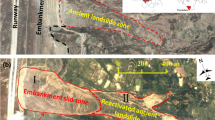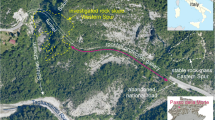Abstract
A catastrophic rock debris avalanche on one of the highlands demarcating Cameroon and Nigeria, 3 days after a transient period of heavy rainfall in November 2010, killed two people and damaged economic trees, plants and farmlands. Detailed field investigation and sampling were undertaken by a team from the International Programme on Landslide to analyse the slope movement. The investigation was in two phases—5 days and then 7 months after the event to study the effect of alternating dry and rainy seasons on the geotechnical properties of the materials associated with the slope failures. It was also aimed at assessing the effect of time on the morphology of the slip plane as a new approach to understanding the development of potential failure planes and reactivated landslides. Available evidence showed that present failure planes form mini-deposition axes which may become future slip zones as they are still steep enough to accelerate instability. The research also traced the pattern of rock weathering and joints evolution in the area and found that the systematic weathering of feldspar in the basement aggravated slope instability by creating zones of weakness characterized by structures that aid fragmentation. Soils were thin (<1 m) in some slopes and deep (>2 m) in others and may represent the differential effect of weathering and erosion on the mountains which are important in analyzing the mechanism and mobility of the failed masses. Samples collected were subjected to various geotechnical laboratory tests such as unconsolidated undrained triaxial, consistency, particle size and permeability tests.











Similar content being viewed by others
References
Blum AE (1994) Feldspars and their reactions. NATO ASI Ser 421:595–630
Chigira M (2001) Micro-sheeting of granite and its relationship with landsliding specifically after the heavy rainstorm in June 1999, Hiroshima Prefecture, Japan. Eng Geol 59(3–4):219–231
Chigira M (2002) Geologic factors contributing to landslide generation in a pyroclastic area: August 1998 Nishigo Village, Japan. Geomorphology 46(1–2):117–128
Chigira M, Nakamoto M, Nakata E (2002) Weathering mechanisms and their effects on the landsliding of ignimbrite subject to vapor-phase crystallization in the Shirakawa pyroclastic flow, northern Japan. Eng Geol 66(1–2):111–125
Chigira M, Wang WN, Furuya T, Kamai T (2003) Geological causes and geomorphological precursors of the Tsaoling landslide triggered by the 1999 Chi-Chi earthquake, Taiwan. Eng Geol 68(3–4):259–273
Egboka BCE, Nwankwor GI, Orajaka IP (1990) Implications of paleo- and neotectonics in gully erosion-prone areas of southeastern Nigeria. Nat Hazards 3:219–231
Finlay PJ, Fell R, Maguire PK (1997) The relationship between the probability of landslide occurrence and rainfall. Can Geotech J 34:811–824
Gostelow TP (1991) Rainfall and landslides. In: Prevention and control of landslides and other mass movements. CEC Report EUR 12918 EN: 37–53, Luxembourg.
Guzzetti F, Peruccacci S, Rossi M, Stark CP (2007) Rainfall thresholds for the initiation of landslides in central and southern Europe. Meteorol Atmos Physics 98:239–267
Igwe O (2012) ICL/IPL regional activities in West Africa. Landslides 9(3):433–437
Igwe O, Sassa K, Wang FW (2007) The influence of grading on the shear strength of loose sands in stress-controlled ring shear tests. Landslides 4(1):43–51
Nigeria Meteorological Agency, NIMET (2010) Nigeria climate review bulletin 2010.http://www.nimetng.org/uploads/publication/2010%20Climate%20Review.pdf
Nwajide CS, Okagbue CO, Umeji AC (1988) Slump debris flows in the Akovolwo Mountains Area of Benue State, Nigeria. Nat Hazards 1:145–154
Okagbue CO (1989a) Stability analysis of a slip-debris flow in the Ogbajala Hills of Benue State, Nigeria. Nat Hazards 2:143–151
Okagbue CO (1989b) Predicting landslips caused by rainstorms in residual/colluvial soils of Nigerian hillside slopes. Nat Hazards 3:133–141
Riebe CS, Kirchner JW, Finkel RC (2004) Erosional and climatic effects on long-term chemical weathering rates in granitic landscapes spanning diverse climate regimes. Earth Planet Sci Lett 224(3–4):547–562
Sassa K, Takei A, Kobashi S (1980) Landslides triggered by vertical subsidences. In: Proc. International symposium on landslides. New Delhi, 7–11 April 1980, 1:49–54
Sassa K, Wang G, Fukuoka H (2003) Performing undrained shear tests on saturated sands in a new intelligent-type of ring shear apparatus. Geotech Test J 26(3):257–265
Sassa K, Wang G, Fukuoka H, Wang FW, Ochiai T, Sugiyama ST (2004) Landslide risk evaluation and hazard mapping for rapid and long-travel landslides in urban development areas. Landslides 1(3):221–235
Sassa K, Nagai O, Solidum R, Yamazaki Y, Ohta H (2010) An integrated model simulating the initiation of earthquake & rain induced rapid landslides and its application to the 2006 Leyte landslide. Landslides 7(3):219–236
Shuzui H (2001) Process of slip-surface development and formation of slip-surface clay in landslides in Tertiary volcanic rocks, Japan. Eng Geol 61:199–219
Siddle RC, Swanston DN (1982) Analysis of a small debris slide in coastal Alaska. Can Geotech J 19(2):167–174
Tamada B, Fukuda J (1987) Dynamic characteristics of the slip surface of the frictional type and their measurements. J Jpn Landslide Soc 24(3):23–39
UNITAR (2010) Estimated average rainfall accumulation: Nigeria for the period of 25–31 & 1–31 October, 2010. United Nations Institute for Training and Research.http://www.unitar.org/unosat/node/44/1520
Wieczorek GF (1987) Effect of rainfall intensity and duration on debris flows in central Santa Cruz Mountains, California. In: Costa JE and Wieczorek GF (eds.) Debris flow/avalanches: processes, recognition and mitigation. Geol Soc Am Rev Eng Geology 7:93–104
Wieczorek GF (1996) Landslide triggering mechanisms. In: Landslides: investigation and mitigation (Turner AK, Schuster RL, eds). Washington: Transportation Research Board, National Research Council, Special Report, 76-90
Yatabe R, Yagi N, Enoki M, Nakamura K (1991) Strength characteristics of slip-surface clay. J Jpn Landslide Soc 28(1):9–16
Acknowledgments
This research was conducted under the International Programme on Landslides Project (Project no. 150). The contributions of Professor Sassa Kyoji, Executive Director ICL, and Professor Fawu Wang of the Department of Geo-science, Shimane University, Japan are highly appreciated.
Author information
Authors and Affiliations
Corresponding author
Rights and permissions
About this article
Cite this article
Igwe, O. The role of weathering in the initiation and mobility of a rare complex avalanche at the Nigeria–Cameroon border, West Africa. Landslides 11, 319–326 (2014). https://doi.org/10.1007/s10346-014-0467-z
Received:
Accepted:
Published:
Issue Date:
DOI: https://doi.org/10.1007/s10346-014-0467-z




